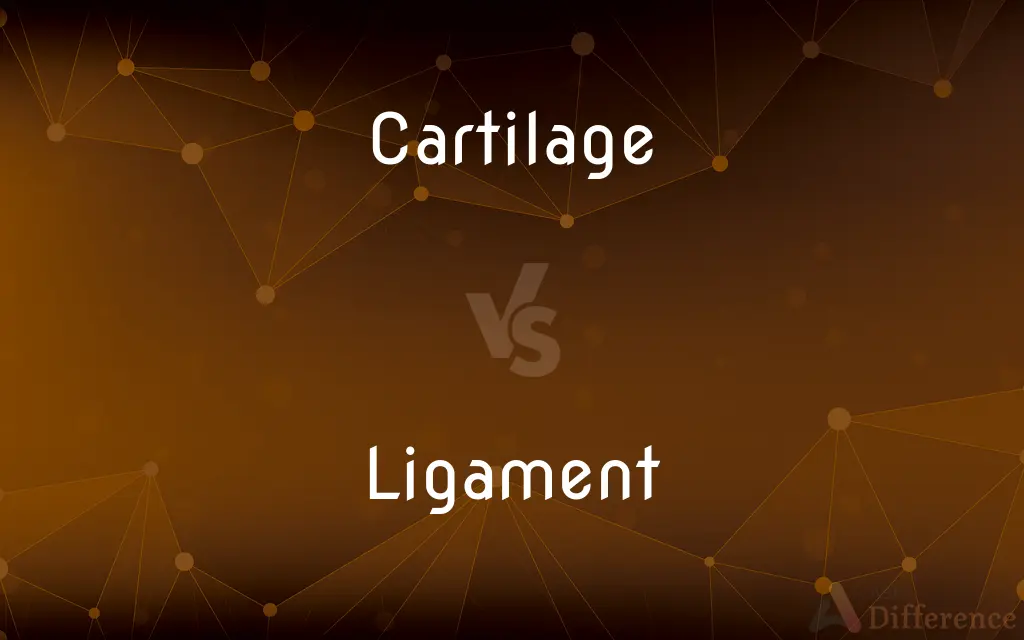Cartilage vs. Ligament — What's the Difference?
Edited by Tayyaba Rehman — By Maham Liaqat — Updated on March 13, 2024
Cartilage is a flexible connective tissue found in various parts of the body, providing support and cushioning. Ligaments are fibrous connective tissues that connect bones to other bones, stabilizing joints.

Difference Between Cartilage and Ligament
Table of Contents
ADVERTISEMENT
Key Differences
Cartilage is a smooth, elastic tissue that covers the ends of bones in joints, reducing friction and acting as a cushion during movement. It is also found in other body parts like the nose, ear, and trachea, providing structure and flexibility. Ligaments, however, are tough, fibrous bands that connect bones to other bones, playing a crucial role in joint stability and preventing excessive movement that could lead to injury.
In terms of composition, cartilage is made up of chondrocytes (cartilage cells) embedded in a matrix of collagen fibers and proteoglycans, which give it its resilient and flexible nature. Ligaments are composed primarily of long, stringy collagen fibers that create a strong, flexible band capable of withstanding tension, supporting the joints they encase.
Cartilage does not have a blood supply, relying instead on diffusion to receive nutrients. This lack of blood supply contributes to its slow healing process. Ligaments have a limited blood supply, which is better than that of cartilage but still results in a relatively slow healing process compared to other tissues.
The primary function of cartilage is to provide support and flexibility to various structures, allowing for smooth movements at joints. Ligaments primarily function to connect bones and provide stability to joints, limiting movements to prevent dislocation or injury.
Both cartilage and ligaments are essential for the skeletal system's functioning, but they serve different purposes. Cartilage provides cushioning and support, allowing for flexible movement, while ligaments are critical for stabilizing joints and preventing excessive or harmful movements.
ADVERTISEMENT
Comparison Chart
Location
Ends of bones, ear, nose, trachea
Connects bones to other bones
Function
Cushioning, support, reducing friction
Stabilizing joints, limiting movement
Composition
Chondrocytes, collagen, proteoglycans
Long collagen fibers
Blood Supply
Avascular (no blood supply)
Limited blood supply
Healing
Slow due to lack of blood supply
Relatively slow, but faster than cartilage
Compare with Definitions
Cartilage
Flexible support structure.
The cartilage in the knee joint acts as a cushion during running.
Ligament
Connects bone to bone.
The ACL ligament connects the femur to the tibia, stabilizing the knee joint.
Cartilage
Avascular tissue.
The slow healing of damaged cartilage in the ankle is due to its lack of blood supply.
Ligament
Limited blood supply.
A sprained ankle can take weeks to heal due to the ligament's limited blood supply.
Cartilage
Found in joints and other areas.
Nasal cartilage gives shape and support to the nose.
Ligament
Crucial for joint stability.
Shoulder ligaments prevent dislocation by stabilizing the joint.
Cartilage
Made of chondrocytes and collagen.
Cartilage in the ear provides flexibility due to its unique composition.
Ligament
Composed of tough collagen fibers.
The ligaments in the wrist provide strong support for hand movements.
Cartilage
Provides smooth joint movement.
Cartilage between vertebrae prevents friction and facilitates smooth spinal movement.
Ligament
Prevents excessive movement.
Ligaments in the spine limit excessive movement to prevent injury.
Cartilage
Cartilage (cartilaginous tissue) is a resilient and smooth elastic tissue, rubber-like padding that covers and protects the ends of long bones at the joints and nerves, and is a structural component of the rib cage, the ear, the nose, the bronchial tubes, the intervertebral discs, and many other body components. It is not as hard and rigid as bone, but it is much stiffer and much less flexible than muscle.
Ligament
A ligament is the fibrous connective tissue that connects bones to other bones. It is also known as articular ligament, articular larua, fibrous ligament, or true ligament.
Cartilage
A tough, elastic, fibrous connective tissue that is a major constituent of the embryonic and young vertebrate skeleton and in most species is converted largely to bone with maturation. It is found in various parts of the human body, such as the joints, outer ear, and larynx.
Ligament
(Anatomy) A sheet or band of tough, fibrous tissue connecting bones or cartilages at a joint or supporting an organ.
Cartilage
A usually translucent and somewhat elastic, dense, nonvascular connective tissue found in various forms in the larynx and respiratory tract, in structures such as the external ear, and in the articulating surfaces of joints. It composes most of the skeleton of vertebrate embryos, being replaced by bone during ossification in the higher vertebrates.
Ligament
A unifying or connecting tie or bond.
Cartilage
A particular structure made of cartilage.
Ligament
(anatomy) A band of strong tissue that connects bones to other bones.
Cartilage
A translucent, elastic tissue; gristle.
Ligament
(figurative) That which binds or acts as a ligament.
Cartilage
Tough elastic tissue; mostly converted to bone in adults
Ligament
Anything that ties or unites one thing or part to another; a bandage; a bond.
Interwoven is the love of liberty with every ligament of your hearts.
Ligament
A tough band or plate of dense, fibrous, connective tissue or fibrocartilage serving to unite bones or form joints.
Ligament
A sheet or band of tough fibrous tissue connecting bones or cartilages or supporting muscles or organs
Ligament
Any connection or unifying bond
Common Curiosities
Why does cartilage heal slowly?
Cartilage is avascular, meaning it lacks a blood supply, which is essential for rapid healing.
Can ligaments stretch?
Ligaments have some elasticity to allow for joint movement, but excessive stretching can lead to injuries such as sprains.
How can damage to cartilage affect joint movement?
Damaged cartilage can lead to reduced cushioning and increased friction in the joint, causing pain and limited mobility.
Is there any way to improve the healing of cartilage?
Treatments are limited due to its avascularity, but methods like physical therapy, injections, and in some cases, surgery, can help manage symptoms and promote healing.
How does aging affect cartilage and ligaments?
Aging can lead to the degeneration of cartilage and reduced elasticity of ligaments, increasing the risk of injury and joint disorders.
How do diseases like arthritis affect cartilage?
Arthritis can lead to the breakdown of cartilage, causing joint pain, stiffness, and reduced mobility.
What is the main difference between cartilage and ligament?
Cartilage provides cushioning and support in joints and other body parts, while ligaments connect bones to bones, stabilizing and supporting joints.
Are there different types of cartilage?
Yes, there are three main types: hyaline cartilage (found in joints), elastic cartilage (found in the ear), and fibrocartilage (found in the intervertebral discs).
What happens when a ligament is damaged?
A damaged ligament can lead to joint instability, pain, and swelling, and may require a long time to heal.
How do athletes protect their ligaments from injury?
Athletes protect their ligaments through strength training, proper technique, and sometimes using braces or supports to stabilize the joints.
Are there any non-surgical treatments for ligament injuries?
Yes, treatments include physical therapy, bracing, and anti-inflammatory medications to manage pain and promote healing.
Why are ligament injuries common in sports?
The high-impact and rapid movement changes in sports can exceed the ligament's capacity to stretch, leading to tears or sprains.
Can cartilage be regenerated?
Cartilage regeneration is challenging, but research into techniques like stem cell therapy and cartilage transplant is ongoing.
Can diet affect the health of cartilage and ligaments?
A nutritious diet can support overall tissue health, but specific effects on cartilage and ligaments are less direct compared to other factors like physical activity and genetics.
What role do ligaments play in knee stability?
Ligaments in the knee, such as the ACL and MCL, are crucial for stability, especially during movements like walking, running, and jumping.
Share Your Discovery

Previous Comparison
Needlepoint vs. Embroidery
Next Comparison
Sucrose vs. LactoseAuthor Spotlight
Written by
Maham LiaqatEdited by
Tayyaba RehmanTayyaba Rehman is a distinguished writer, currently serving as a primary contributor to askdifference.com. As a researcher in semantics and etymology, Tayyaba's passion for the complexity of languages and their distinctions has found a perfect home on the platform. Tayyaba delves into the intricacies of language, distinguishing between commonly confused words and phrases, thereby providing clarity for readers worldwide.













































